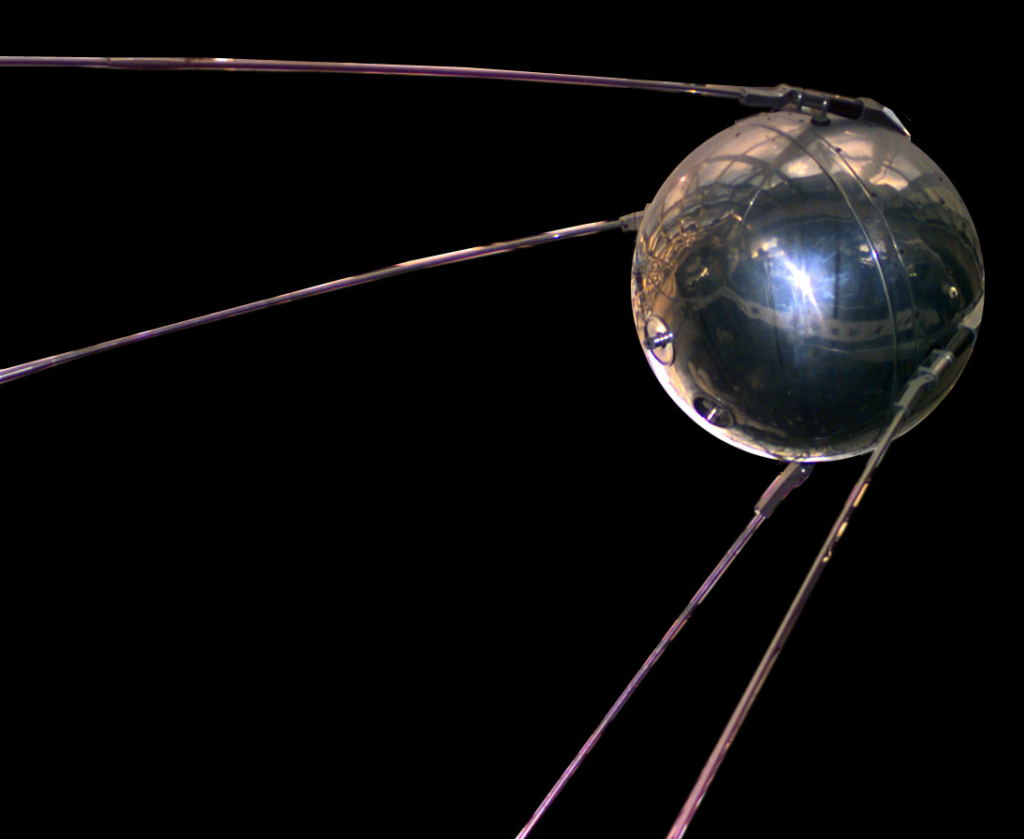Long shot research won’t fix what ails US health care
By John Alic | May 25, 2023
 In the aftermath of the Soviet launch of Sputnik in 1957, the first artificial satellite, the US government created the Advanced Research Projects Agency or ARPA to streamline US military research. The government has turned to the agency, now known as DARPA, as a model in trying to revitalize government performance in several areas, most recently, health research. Credit: NASA
In the aftermath of the Soviet launch of Sputnik in 1957, the first artificial satellite, the US government created the Advanced Research Projects Agency or ARPA to streamline US military research. The government has turned to the agency, now known as DARPA, as a model in trying to revitalize government performance in several areas, most recently, health research. Credit: NASA
In the beginning, DARPA (the Defense Advanced Research Projects Agency) was just ARPA. Established in the wake of the Soviet Union’s Sputnik satellite launch, it was supposed to take over the plethora of missile and space programs run by the US armed forces. Overlap and competition among these programs had gotten much of the blame for the black eye that Sputnik—the world’s first artificial satellite and a clear technological coup—delivered to national prestige. But as a civilian-run organization, ARPA faced strong opposition from the military and could not long hold onto its assigned mission. Forced to find another, it focused on insertion of advanced technologies into fielded weapon systems. It wasn’t truly a research agency in its original or later incarnation, but DARPA has been widely lauded for spurring the development of the internet (originally known as ARPANET) and stealthy warplanes, among other advances.
In recent decades, attempts to mimic DARPA’s approach have arisen in intelligence (the Intelligence Advanced Research Projects Activity), energy (ARPA-E, or the Advanced Research Projects Agency-Energy), and now health. Congress gave the Advanced Research Projects Agency for Health (ARPA-H) an initial $1 billion appropriation for fiscal 2022 and in September of that year President Joe Biden appointed the agency’s first director. Congress followed up with $1.5 billion for 2023 and ARPA-H is seeking $2.5 billion for 2024. This is over half of DARPA’s 2024 request and nearly four times that of ARPA-E, both of which are established agencies, while ARPA-H is still in the start-up and planning stages. The size of ARPA-H appropriations underscores the high expectations of Congress and the White House.
As with earlier ARPAs, the original idea was to seed radical innovation in an existing agency. In the case of ARPA-H, that would be the National Institutes of Health (NIH), the massive agency which is the largest funder of biomedical research in the world, sitting within the Department of Health and Human Services. According to the department, “ARPA-H will recruit visionary term-limited program managers who can identify and fund traditional and non-traditional partners to take on critical challenges that are unlikely to move forward quickly without this catalytic assistance.” In other words, talented visionaries will steer funding to potentially groundbreaking biomedical research that wouldn’t otherwise get government backing.
ARPA-H will find itself in a very different institutional setting than its forbearer DARPA. In the case of latter, its goal is to develop new technologies for incorporation in fielded military systems. In the case of ARPA-H, however, it sits attached to a massive research agency that is removed from the actual business of delivering health care.
ARPA-H has announced its mission “to accelerate better health outcomes for everyone.” Even finding a way to apply government-funded biomedical research in health care will be difficult. Other programs created in this vein, like the National Center for Advancing Translational Sciences, have faced hurdles attempting to “translate” research into applications. But given the ambition of its mission, ARPA-H will have to grapple with an even broader problem, since delivery of better health care for all is not primarily a technological problem solvable by research-driven innovation. Although the armed services have sometimes resisted DARPA innovations, they at least are nominally subject to higher authorities within government. ARPA-H and its mission to drive high quality care into the entire health system will instead face a sector dominated by private, profit-seeking, and politically powerful business enterprises.
Situating DARPA. The United States reacted to Sputnik with something close to panic. Not only had the Soviet Union won the first heat in the space race, Sputnik showed the entire world that nuclear-tipped intercontinental missiles would be next.
At the time, the US Army, Navy, and Air Force had nearly 30 rocket, missile, and space launch programs underway. None were close to achieving orbital flight. Internecine competition drew much of the blame. To at least quiet the clamor in Congress, former Secretary of Defense Neil McElroy forced into being a civilian-managed agency, dubbed ARPA, to take over the efforts. Naturally, the armed forces resisted.
The military had traditionally enjoyed nearly complete authority over design, development, and production of weaponry, leaving aside only World War II when mobilization and military operations came first. Afterwards the armed forces took back control of research and development (R&D), with the sole exception of nuclear warheads, transferred over Pentagon objections to the civilian Atomic Energy Commission. By the time of Sputnik, the services employed thousands of civilian engineers and scientists. All reported, directly or indirectly, to military officers who made most of the final decisions. (D)ARPA’s break with this pattern was the source of their opposition and the military soon managed to claw back weapons-related missile and space programs. With the congressionally-established National Aeronautics and Space Administration taking over projects less directly linked with warfighting, (D)ARPA had lost its defining mission.
The agency’s managers had to find a new job description.
This they did by reinventing their organization as funder of R&D that fell between the cracks of the self-defined warfighting missions of the individual services, or that senior military officers, few of whom could claim much technical expertise, overlooked, ignored, or dismissed. The need was plain, and still is.
The armed forces have sometimes done a good job with advanced technologies, as the Air Force showed with the Minuteman missile and the Navy with Polaris. But not always. The Army’s Future Combat System, an overambitious effort to integrate manned and unmanned systems, spent some $20 billion on R&D. When finally canceled in 2009, after nearly a decade, those billions left hardly a trace on fielded weaponry.
DARPA itself has had successes and failures. In pushing stealth in the 1970s it had to overcome an indifferent Air Force run by pilots brought up to engage in aerial combat. These airmen had no wish to hide from the enemy—the more so in subsonic aircraft with flight characteristics so poor they could not stay airborne without computer assistance no matter a pilot’s top-gun skills. Unsurprisingly, the service dragged its collective feet. DARPA prevailed because of strong backing from high-level civilians elsewhere in the Pentagon. But with the stillborn arsenal ship, intended as a platform for precision-targeted smart munitions, the agency could not; the Navy soon abandoned the program for lack of internal support.
In breathless journalistic accounts and elsewhere, DARPA’s place and function within the Department of Defense has been frequently misunderstood. Although DARPA has always funded some basic research, this is not its primary function. One of its new initiatives, for example, seeks ways to beam energy over long distances through the atmosphere. Research will be part of this, but—like GPS—it is more nearly an engineering project. If successful, the work could have spinoff potential, perhaps even as an enabler for space-based solar power. But this is not DARPA’s goal; it seeks practical means to power far-flung military bases in the Pacific in order to avoid endangering supply ships and cargo aircraft that would be subject to attack in the event of war with China.
ARPA-H’s mission. The impetus for ARPA-H came from a perceived tilt in research funded by NIH toward safely conservative work at the expense of riskier ventures thought by some to promise genuine breakthroughs. The agency, according to its website, “supports the development of high-impact research to drive biomedical and health breakthroughs to deliver transformative, sustainable, and equitable health solutions for everyone.” It will focus on “leveraging research advances for real world impact.” ARPA-H, in other words, is expected to search out and fund high-risk research with high potential rewards, but not just that, it will also be expected to help spread the resulting benefits to all Americans. This will be a challenge, for several reasons, not the least of which is that the problems with the US health care system likely can’t be solved by research-driven innovation. Social policy innovations to reshape the delivery system will be needed.
By definition risky projects elevate the likelihood of failure. And there are no established methods for choosing promising research directions, no algorithms, no way to estimate probabilities. This means that ARPA-H, like any organization pursuing radical innovation, must rely on human judgment. The difference is that DARPA-like organizations rely on agency review and put their trust in the judgment of individuals and small working groups rather than the broad collective peer review processes that underlie selection mechanisms in agencies such as NIH. ARPA-H will also be venturing into areas where NIH has arguably stumbled in the past, that of making the products of research clearly useful.
“Translation,” seeking to accelerate the applications of research, has long been a struggle for NIH. That’s partly because developing applications has long been considered, in the United States, the purview of the private sector. In 2011, for example, Congress established the National Center for Advancing Translational Sciences to “radically speed up the development of new drugs, devices and diagnostics,” overriding the objections of members who criticized the center’s goal as an encroachment on the prerogatives of private firms. By 2023, the center was receiving just $923 million, only 2 percent of NIH’s discretionary spending, and in marked contrast to ARPA-H NIH seeks no increase for 2024.
NIH research and health care. In 1930, Congress gave a new name, the National Institute of Health (singular), to an obscure laboratory attached to the Public Health and Marine Hospital Service. With cancer research growing faster than other research, legislators went on to establish the National Cancer Institute, pluralized the parent agency’s name, and in a departure from existing practice, authorized the Cancer Institute to fund extramural research alongside internal work conducted by civil service employees. NIH, now shelters 27 institutes and centers and over 80 percent of research dollars go to extramural projects. The NIH budget, some $50 million in 1950, will soon surpass $50 billion.
If DARPA’s customers have always been internal to the Pentagon and the defense industry—the Defense Department spends around $250 billion dollars each year on goods and (non-R&D) services purchased from private firms—the beneficiaries of NIH research have looser and less direct ties with government.
Companies in the biopharmaceutical industry pluck the fruits of publicly-funded research. If successful drug developments follow, they are allowed under US law to move them behind an iron curtain of patent protection. Those products that reach the market often yield extraordinary profits, since the patents allow pharmaceutical companies to set prices at extraordinary levels. Other stakeholders include firms manufacturing medical devices such as surgical robots and the many thousands of scientists in research universities and medical schools constantly clamoring for research dollars.
APRPA-H joins an ecosystem in which ordinary Americans in need of health care have much to gain in principal and sometimes in practice from NIH research, as the rapid development of COVID-19 vaccines showed so dramatically. Yet this was something of an exception, a consequence of massive direct subsidies to vaccine makers through Operation Warp Speed. More commonly, advances with a link to government funded biomedical research come slowly and often fail to reach vulnerable slices of population.
The government’s massive investment in biomedical research belies a particularly yawning gap in terms of public benefit. With public health responsibilities hived off long ago to the Food and Drug Administration and Centers for Disease Control and Prevention, agencies with budgets far smaller than NIH, by almost any yardstick the United States grossly underspends in this critical area, a fact made clear during the COVID-19 pandemic.
Indeed, to partially rectify the disconnect between US research funding and concrete public health deliverables, like pandemic countermeasures, Congress in 2006, established the Biomedical Advanced Research and Development Authority (BARDA). The agency had the mission of providing “an integrated, systematic approach to the development of the necessary vaccines, drugs, therapies, and diagnostic tools …. to keep Americans safe from emerging infectious diseases …”
Yet BARDA’s budget, like that for translation sciences, remains small, with a little over $1 billion requested for 2024. COVID revealed BARDA’s inadequacies, and it is far from plain that it will be able to do all that much better when the next pandemic comes along.
Steering R&D investment. Unlike private firms, government agencies can hardly ever be torn apart and rebuilt absent a cataclysmic shock such as that delivered by World War II. Nor can public officials sweep away organizational obstacles as easily as corporate executives. Instead, federal agencies add new pieces, growing by accretion. This was how DARPA came to be, as well as the National Center for Advancing Translational Sciences, BARDA, and ARPA-H. As remedies, such steps can come to seem uncomfortably like band-aids in place of more nearly surgical forms of restructuring. Yet given politico-bureaucratic realities, this is about all that is possible.
The consequences have been plain to see. The US military, built to fight big wars, and to deter them, is the most powerful in the world and also the most costly. The US health care system is the most costly in the world by far yet delivers mediocre care on average to most Americans, depending in part on where they happen to live, on social status, on whether they have insurance coverage through an employer, and on myriad other factors. In other wealthy countries, health care is a human right. Not so in the United States. To fully live up to its mission statement, ARPA-H will have to meaningfully address the pathologies afflicting US health care. Few of these have much to do with research, and any serious effort promises to generate powerful opposition by the private entities that dominate the nation’s health care system. When ARPA parachuted into Defense Department long ago, it faced internal opposition and was forced to change course. ARPA-H may likewise face some reinvention in the years ahead.
Together, we make the world safer.
The Bulletin elevates expert voices above the noise. But as an independent nonprofit organization, our operations depend on the support of readers like you. Help us continue to deliver quality journalism that holds leaders accountable. Your support of our work at any level is important. In return, we promise our coverage will be understandable, influential, vigilant, solution-oriented, and fair-minded. Together we can make a difference.
Keywords: ARPA-H, DARPA, NIH, science and technology
Topics: Biosecurity















